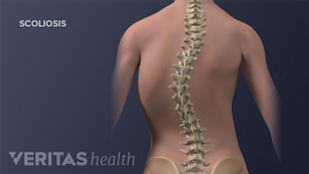Some teens completely refuse to wear a rigid brace to treat scoliosis, perhaps fearing comments or jokes made by peers, or simply believing that the treatment is not worth the hassle. In other cases, a teen may seem willing to wear the brace, but does not meet the prescribed hours per day because of too many breaks from wearing it or not wearing it tightly enough.
Wearing a back brace can be an effective way to keep a scoliosis curve’s Cobb angle relatively small and manageable. ReadBracing Treatment for Idiopathic Scoliosis
不管为什么规定一个十几岁不戴支具,这是一个问题,脊柱侧弯有机会恶化,可能需要重大手术前需要解决的问题。
See脊柱侧弯手术
提示说服青少年坚持使用支具
If a teen is reluctant to wear a brace for scoliosis, it is important to learn why. Give the teen an opportunity to talk about how he or she feels about the brace. Once the main concerns are stated, it becomes easier to work together to find solutions.
例如,如果青少年表现挫折挑选衣服与戴支具,在线一起去,看看其他青少年脊柱侧弯已经上市的建议。
Other tips include:
- Acknowledge the temporary inconvenience.The brace does take extra time and energy to put on, other people will have comments or questions, and it will feel uncomfortable—especially in the beginning.
- Explain why bracing works.Scientific studies continue to show that the more hours per day that are spent in a properly fitting brace, the less likely the scoliosis curve will progress to the point of needing surgery.1A rigid (not soft) brace works by applying pressure to the growing spine in a manner that reduces the chances of the curve worsening during the growth spurt.
- 获得家人和朋友提供支持。A teen is more likely to wear a brace if parents and friends are supportive. In particular, if a parent is against the idea of bracing, the child is less likely to wear the brace as prescribed. Sometimes it makes sense to convince the parent(s) that bracing is the correct treatment option before the adolescent will agree to it.
- 检查是否夜间支具是一种选择。While some studies suggest that more time spent in the brace lowers the risk for curve progression, other studies have suggested that nighttime braces (only worn while sleeping for at least 8 hours per night) can also be successful for some scoliosis patients. This solution could potentially help the patient avoid wearing the brace during the day, but it depends on the type of scoliosis curve.2,3
- 探索撑传感器的可用性。Studies have shown that when electronic sensors are used to track brace compliance and adolescents are counseled about the results by their doctor, they are more likely to wear the brace for the prescribed hours per day.4These sensors can be especially helpful in identifying when the patient is taking too many breaks from the brace or not wearing it tightly enough. Some sensors are heat sensitive while others are pressure sensitive.
最终,选择戴支具的规定由医生到青春期。听着他或她的顾虑和解决方案的合作可以提供让青少年同意支撑的最好机会。
In This Article:
- Adolescent Idiopathic Scoliosis and Emotional Health
- 如何发现抑郁症与脊柱侧弯的青少年
- When a Teen with Scoliosis Won’t Wear a Back Brace
- Long-Term Outlook for Adolescents Who Have Scoliosis Surgery
- 特发性脊柱视频
怎么样替代准备迎接脊柱侧弯?
Sometimes if the patient or parents are against the idea of treating scoliosis with a rigid brace, they will seek out other treatment options. Below are some examples:
- Soft braces.这些支架,也称为动态牙套,由纵横交错的躯干和连接到骨盆周围穿着的基地一定柔性吊带。但是,为了支持使用软括号的科学是没有那么强的刚性支撑。1Also, unlike a rigid brace, a soft brace (partially worn beneath the pants) must be removed before using the bathroom.
- 练习。There are some cases in the medical literature where physiotherapeutic scoliosis-specific exercises (PSSE)—which target specific muscles surrounding the spine for strengthening and stretching—have reduced a scoliosis curve’s size. However, the scientific evidence has been relatively weak thus far. While exercise is a good idea to help complement the use of a rigid brace, it is not advised as a replacement for bracing.5
- 手术。Some teens want to skip bracing and go directly to having surgery. This preference fails to consider that scoliosis surgery is major surgery with potentially serious risks. Typically, a scoliosis curve needs to get to 45 or 50 degrees before the surgery’s potential benefits outweigh the potential complications.
目前,刚性支撑是具有用于防止恶化,减少需要大手术的机会曲线强有力的科学证据侧弯唯一的非手术治疗。1
See争议在是否支护工程
References
- 1.Weinstein SL, Dolan LA, Wright JG, Dobbs MB. Effects of bracing in adolescents with idiopathic scoliosis. N Engl J Med. 2013; 369:1512-1521.
- 2.Lateur G, Grobost P, Gerbelot J, Eid A, Griffet J, Courvoisier A. Efficacy of nighttime brace in preventing progression of idiopathic scoliosis of less than 25°. Orthop Traumatol Surg Res. 2017;103(2):275-278.
- 3.李CS,黄某CJ,金DJ等。的查尔斯顿夜间在脊柱侧凸的治疗弯曲支柱的有效性。Ĵ儿科杂志骨科。2012;32(4):368-72。
- 4.Karol LA, Virostek D, Felton K, Wheeler L. Effect of compliance counseling on brace use and success in patients with adolescent idiopathic scoliosis. J Bone Joint Surg Am. 2016; 98(1):9-14.
- 5.物理疗法脊柱侧弯具体的练习SRS声明。脊柱侧弯研究学会的网站。发布时间2014年访问时间2017年3月20日。







